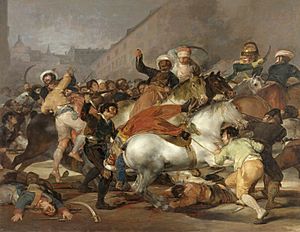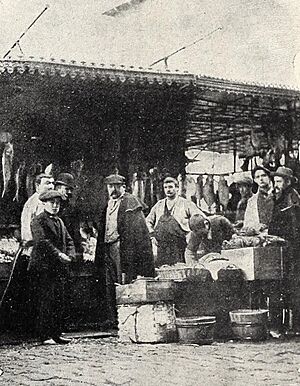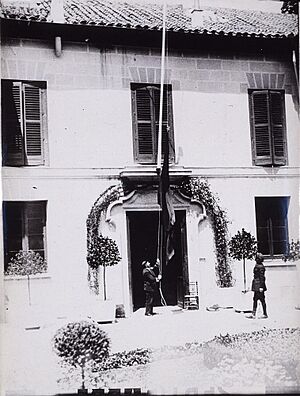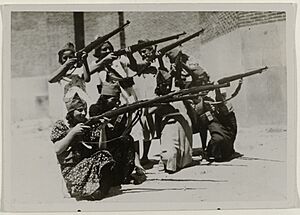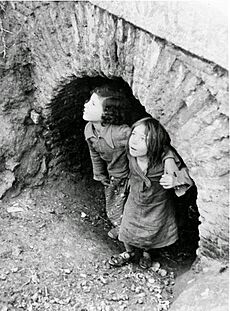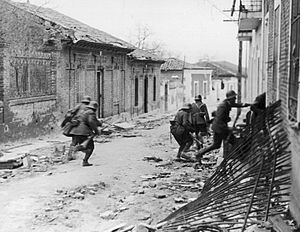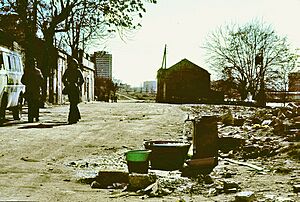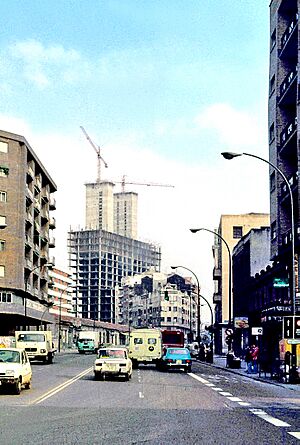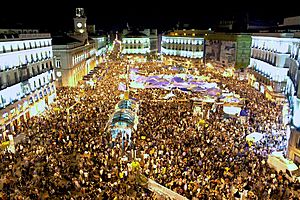History of Madrid facts for kids
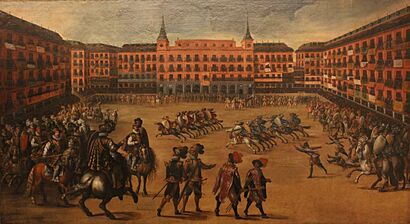
The story of Madrid officially begins in the 800s, even though people lived in the area since the Stone Age. Madrid started as a small walled fort built by Muslim rulers in the 800s. It was located on the banks of the Manzanares River. Christians took control around 1085, and Madrid grew into an important town in the Crown of Castile. Madrid became the capital of the Spanish Monarchy in 1561. This made it a very important administrative center.
Contents
Early Days: Fortress and Town

Madrid's first settlement, called Majriṭ, was built in the late 800s. It was a fort created by Muhammad I, the Muslim ruler. The fort was on a hill next to the Manzanares River. It was mainly a military base for soldiers. This fort helped stop armies from the Asturian kingdom from reaching Toledo.
Muslim Madrid covered about 8 hectares. It included a royal palace (the alcázar) and a larger walled area (al-Mudayna). There were also some houses outside the walls. By the late 900s, Majriṭ was a key military stronghold. It was important because it was close to Toledo. Around 2,000 people might have lived in this 9-hectare settlement in the 900s.
After the Christians took over, a writer named Al-Idrisi described Madrid in the early 1100s. He called it a "small city and solid fortress, well populated." He also mentioned a small mosque that was later turned into a church.
Madrid Becomes Christian
Madrid came under Christian rule when Toledo was conquered. This happened around 1085. The mosque in Madrid was changed into a church dedicated to the Virgin of Almudena. In the 11th and 12th centuries, knights were important leaders in Madrid's society.
Madrid had people who were already living there, including Muslims and Mozarabs (Christians who lived under Muslim rule). Many Muslims stayed after the conquest. New settlers, mostly from Castile and León, also moved in. A small but important group of Frankish settlers also lived there. The Jewish community was smaller. By the 1400s, Muslim master builders, called alarifes, were very important. They worked on public projects and helped shape the town's buildings.
Growing Pains and Royal Attention

From the mid-1200s to the late 1300s, Madrid competed with Segovia for control of the Real de Manzanares area. Segovia was a powerful town known for its livestock farming. Madrid was more focused on farming and was not as good at attracting new settlers.
Before the 1400s, Madrid's economy was mostly based on farming. They grew many irrigated crops. Making building materials and leather were also important industries.
In 1383, John I of Castile gave Madrid to Leo V of Armenia. But Madrid's council made sure that this gift would not be passed down through families. They also got a promise that the Crown would never sell Madrid to another lord.
Later, Henry III of Castile (1379–1406) rebuilt Madrid after a fire. He also founded El Pardo just outside the city walls.
During the 1400s, Madrid became a favorite place for the kings of the Trastámara family. John II of Castile and Henry IV of Castile spent a lot of time there. Kings liked Madrid because of the good hunting nearby and its important location. The strong alcázar (royal palace) was also a safe place for the royal treasury. Madrid even had a mint for making coins from 1467 to 1471. The Catholic Monarchs also visited Madrid often, staying for more than 1,000 days.
By the end of the Middle Ages, Madrid was a medium-sized to large town in Castile. It had a vote in the Cortes of Castile (a type of parliament) and many small churches and hospitals.
Changes in Society
When the Jews were ordered to leave Spain in 1492, most Jews in Madrid chose to convert to Christianity instead of leaving. They became a group called conversos. Similarly, when Muslims were forced to convert in 1502, many became Christians. The city council even offered tax benefits and gifts to encourage them to convert.
The Revolt of the Comuneros happened in Madrid in 1520–21. Rebels took control of the city and removed the local governor. Some leaders were captured, but the revolt ended with talks.
Madrid Becomes the Capital
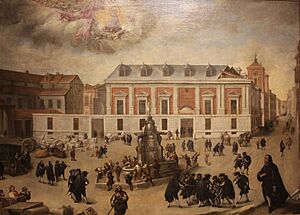
Philip II moved the royal court to Madrid in 1561. This made Madrid the unofficial capital. At that time, Madrid had fewer than 20,000 people. By the end of the 1500s, it grew to almost 100,000.
The population dropped by half when the capital moved to Valladolid for five years (1601–1606). This move was encouraged by the Duke of Lerma, a close advisor to Philip III. The Duke had bought many properties in Valladolid. Madrid faced a big economic crisis, and house prices fell sharply. The Duke then bought cheap land in Madrid and suggested moving the capital back. The king agreed after Madrid offered 250,000 ducats to help pay for the move.
Life in 17th Century Madrid
In the 1600s, Madrid's society was divided into different groups.
- Nobility: A large group of rich and powerful people who lived near the royal court.
- Clergy: Church leaders, often from noble families. Lower clergy usually came from humble backgrounds.
- Civil Servants: People who worked for the government. They had good social standing.
- Craftsmen, Traders, Goldsmiths: A smaller number of skilled workers and merchants.
- Domestic Staff: Many people worked as servants, like pages, squires, and butlers. Some wealthy families also owned slaves, which was a sign of their status.
- Poor: At the bottom were homeless people, unemployed immigrants, and former soldiers.
Madrid grew quickly in the 1600s. The royal court attracted many famous Spanish artists and writers. These included Cervantes, Lope de Vega, and Velázquez. This period is known as the "Golden Age" of Spanish culture.
Madrid in the 18th Century
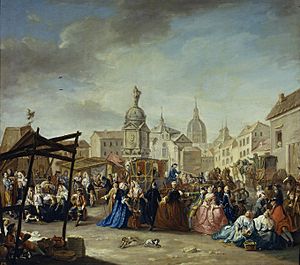
By the late 1700s, Madrid had a large population of enslaved people. Estimates range from 6,000 to 15,000 out of over 150,000 residents. Unlike other Spanish cities, there were more enslaved men than women in Madrid during this time.
In 1739, Philip V started building new palaces, like the Palacio Real de Madrid. Under Charles III (1716–1788), Madrid truly became a modern city. Charles III improved the city and its government. He was so popular that people said, "the best mayor, the king." Besides finishing the Royal Palace, Charles III was responsible for many of Madrid's beautiful buildings and monuments, including the Prado Museum and the Puerta de Alcalá.
In 1766, there were big riots in Madrid called the "Mutiny of Esquilache." This happened during a time when food was scarce and prices were high. A new minister, the Marquis of Esquilache, tried to modernize the city. He installed new streetlights, which raised oil prices. He also banned traditional Spanish clothing (long capes and wide-brimmed hats) to make it easier to identify criminals. These changes made people angry, leading to the riots.
By the late 1700s, more carriages in the city led to more accidents. Authorities tried to control traffic by limiting the number of animals per carriage. Eventually, they even banned carriages from the city in 1787.
French Invasion and Uprising
On October 27, 1807, Spain's King Charles IV and Napoleon signed a treaty. It allowed French troops to pass through Spain to invade Portugal. In February 1808, Napoleon sent a large army into Spain. French troops occupied cities like Barcelona and Pamplona, going against the treaty.
Meanwhile, a revolt happened in Spain on March 17, 1808. It was led by Charles IV's son, Ferdinand. Charles IV gave up his throne, and Ferdinand became King Ferdinand VII. In May 1808, Napoleon's troops entered Madrid.
On May 2, 1808 (known as Dos de Mayo), the people of Madrid revolted against the French forces. This uprising had a big impact on how the French were seen in Spain and Europe. Napoleon then forced both King Charles IV and King Ferdinand VII to give up their thrones. He gave the Spanish throne to his brother, Joseph Bonaparte.
The revolt started when people saw French soldiers taking members of the royal family from the palace. When they saw a young prince struggling, the crowd attacked the carriages, shouting, "They're taking him away from us!" French soldiers fired into the crowd. The fighting lasted for hours. This event is shown in Goya's famous painting, The Second of May 1808.

Most Spanish soldiers stayed in their barracks and did nothing. Only the artillery barracks at Monteleón resisted. Captain Luis Daoíz y Torres and other officers fought bravely against the French. They gave weapons to the people. Both Spanish commanders died fighting. Hundreds of Spanish people and French soldiers were killed.
On August 12, 1812, English and Portuguese troops entered Madrid after defeating the French in Salamanca. They surrounded the French-held area in Retiro. After two days, 1,700 French soldiers surrendered. A large amount of weapons and supplies were captured.
After the war, Ferdinand VII returned to the throne in 1814. Many plans to improve the city were stopped because there was no money. Later, a liberal military revolution forced the king to follow the Constitution.
Madrid as Capital of the State
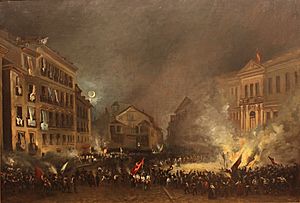
When Isabella II became queen, Madrid was still a walled city. It had slow population growth but was very crowded. After administrative changes in 1833, Madrid became the capital of the new liberal state.
Madrid changed a lot in the 1830s. Old government roles were replaced with new ones, like the constitutional mayor.
In 1835–1836, new laws led to the government taking church properties. Many churches, convents, and their gardens were torn down. This helped make streets and squares wider.
In 1854, there was an economic and political crisis. A military uprising started near Madrid. This led to a popular rebellion in Madrid, known as the Revolution of 1854. People built barricades in the streets. The new government quickly stopped the uprising, leading to deaths and injuries.
Modernizing the City

The year 1858 was important for Madrid because water from the Lozoya River arrived. The Canal de Isabel II was opened on June 24, 1858. A big celebration took place, with a 30-meter-high water fountain in the middle of a street.
A plan to expand Madrid, called the Ensanche de Madrid, was approved in 1860. This plan separated rich, middle-class, and working-class areas. The southern part of the expansion, near the river, became a poorer area with sewage runoff. Beyond these planned areas, slums and poor neighborhoods grew in places like Tetuán and Vallecas.
In 1865, student protests happened after a law was passed against expressing ideas against the monarchy. Protests grew, and on April 10, 2,000 protesters clashed with police. This event, known as the "Night of Saint Daniel," resulted in 14 deaths and many injuries and arrests. It was a sign of more serious revolutionary attempts to come.
The Glorious Revolution in September 1868 led to Queen Isabella II being removed from power. The uprising in Madrid on September 29 forced the queen to leave Spain. General Juan Prim, a leader of the liberals, was welcomed by the people of Madrid. He gave a famous speech against the royal family.
On December 27, 1870, General Prim, who was the prime minister, was shot in his car. He died three days later.
In 1871, Madrid got its first public transportation system: the tram service. This came before buses.
Economic Growth and New Technologies
Madrid's economy continued to modernize in the late 1800s. It became a center for services and finance. New industries included book publishing, construction, and low-tech manufacturing. The arrival of railway transport helped Madrid's economy a lot. It changed what people ate (fresh fish instead of salted fish) and made Madrid a key logistics hub for distributing goods across the country.
Electric power came to Madrid in the late 1800s. Because the city council could not give one company a monopoly, many electricity companies competed. This meant that in some parts of central Madrid, five different power networks ran through the same street! Electric street lighting was introduced in the 1890s.
By the end of the 1800s, Madrid had good water access, a central role in the rail network, cheap workers, and access to money. In the early 1900s, the southern part of the city (now the Arganzuela district) started to become the main industrial area.
In the early 1900s, Madrid began a big project in its city center: the creation of the Gran Vía. This large street cut through the city, requiring many houses and small streets to be torn down. Construction officially began in April 1910, led by King Alfonso XIII.
Madrid also became Spain's cultural capital. It had top universities and academies. Most publishing houses and big newspapers were there, making it a center for intellectual work.
In 1919, the Madrid Metro opened its first line, from Sol to Cuatro Caminos.
Between 1919 and 1920, Madrid saw its biggest wave of protests and strikes. This set the stage for social unrest in the 1930s.
The Second Republic and Civil War
In 1931, when the monarchy ended, Madrid faced problems like many children not getting an education and high unemployment.
When the Second Republic was declared on April 14, 1931, people in Madrid believed they could now freely access the Casa de Campo. This large park had been a private royal property. On April 15, people informally occupied the area. A decree on April 20 gave the park to Madrid's citizens. The transfer was made official on May 6. The Spanish Constitution of 1931 specifically named Madrid as the state capital.
In the 1930s, Madrid was a lively and modern city. The city's cultural life grew a lot. Illiteracy rates dropped below 20%. However, there were also tensions between anti-church groups and Catholics. The burning of convents in May 1931 made the political situation worse.
To fight unemployment, the new city council hired many jobless people as gardeners and street cleaners.
A project was planned to create a "Great Madrid" by extending the Paseo de la Castellana north. This included building the Nuevos Ministerios government complex. Work also continued on the University City, which had started in 1929.
The Spanish Civil War
In July 1936, a military uprising tried to take control of Madrid. But loyal forces and workers' militias defeated it. On July 20, armed workers and loyal troops stormed the Cuartel de La Montaña barracks. This was the last place rebels were holding out. The city became a symbol of popular resistance.
From 1936 to 1939, Madrid remained under the control of forces loyal to the Republic. As rebel troops advanced, Madrid was bombed from the air. The first bombing happened on the night of August 27–28, 1936. Madrid became the first large European city to be bombed by airplanes.
Rebel General Francisco Franco took a detour to "liberate" the besieged Alcázar de Toledo. This gave Republicans in Madrid time to build defenses and get foreign help.
In late 1936, Madrid saw harsh actions by some groups, including the killing of prisoners. This stopped by early December. Madrid was under siege from October 1936 and faced a major attack in its western suburbs in November.
In the final weeks of the war, a military coup happened in Madrid. It was led by Colonel Segismundo Casado against the Republican government. This caused a small civil war within Madrid, resulting in about 2,000 deaths in March 1939.
The city fell to the nationalists on March 28, 1939.
After the War
After the war, the Francoist dictatorship began. There was little freedom and harsh punishment for people linked to the Republic. The city faced shortages, and food was rationed until the mid-1950s. Starvation and lack of protein caused high death rates.
Despite the country being ruined, the new government had big plans for Madrid. They wanted to build a city that showed "Spanish greatness." They planned to improve the area along the Manzanares River, called the "Imperial Cornice." This included finishing the unfinished cathedral (which was finally completed in the late 1900s). However, most of these grand projects were never finished due to the lack of money after the war.
Madrid's population grew rapidly as people moved from rural areas. This led to many new houses being built on the city's edges. Initially, many of these were poor-quality homes, with as many as 50,000 shacks around the city by 1956. Later, better temporary housing was built to replace the shacks.
From 1948 to 1954, Madrid greatly increased its size by adding 13 surrounding towns. Its total area grew from 68.42 square kilometers to 607.09 square kilometers.
The city's population reached its highest point in 1975, with over 3.2 million people.
Recent Developments
In the 1980s, Madrid became very prosperous. It strengthened its position as the leading economic, cultural, industrial, educational, and technology center of the Iberian Peninsula. The population decline seen since 1975 reversed in the 1990s. By the end of the 20th century, Madrid had recovered a population of about 3 million.
During the time José María Álvarez del Manzano was mayor, many traffic tunnels were built under the city.
On March 11, 2004, Madrid was hit by a terrorist attack. Terrorists placed bombs on several trains during the morning rush hour. This attack killed 191 people and injured 1,800.
After Álvarez del Manzano, other conservative mayors tried three times to host the Summer Olympics (for 2012, 2016, and 2020), but they were not successful. Madrid was a center for the anti-austerity protests that started in Spain in 2011. These protests were a result of the 2008 financial crisis. Madrid has also been affected by rising numbers of empty homes and house evictions.
The left-wing mayor Manuela Carmena (2015–2019) worked to bring the Manzanares River back to a more natural state through the city.
Since the late 2010s, Madrid has faced challenges like rising rental prices. This is often linked to gentrification and a lot of tourist apartments in the city center. There has also been a big increase in betting shops in working-class areas, which is a concern for young people.
Population Growth Over Time
| Year | Population | |
|---|---|---|
| 1530 | 4,000–5,500 | |
| 1600 | 30,000 | |
| 1700 | 110,000 | |
| 1800 | 160,000 | |
| 1850 | 281,000 | |
| 1872 | 333,745 | |
| 1880 | 398,000 | |
| 1900 | 539,835 | |
| 1910 | 599,000 | |
| 1930 | 952,000 | |
| 1959 | 2,000,000 | |
| 1968 | 3,000,000 | |
| 1975 | 3,228,057 | |
See also
 In Spanish: Historia de Madrid para niños
In Spanish: Historia de Madrid para niños
- Timeline of Madrid



